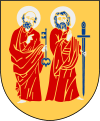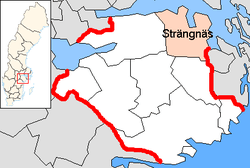Strängnäs Municipality
Strängnäs Municipality (Strängnäs kommun) is a municipality in Södermanland County in eastern Sweden, located by Lake Mälaren. Its seat is located in the city of Strängnäs.
Strängnäs Municipality Strängnäs kommun | |
|---|---|
 Strängnäs Courthouse | |
 Coat of arms | |
 | |
| Country | Sweden |
| County | Södermanland County |
| Seat | Strängnäs |
| Area | |
| • Total | 975.08 km2 (376.48 sq mi) |
| • Land | 739.7 km2 (285.6 sq mi) |
| • Water | 235.38 km2 (90.88 sq mi) |
| Area as of 1 January 2014. | |
| Population (31 December 2019)[2] | |
| • Total | 36,544 |
| • Density | 37/km2 (97/sq mi) |
| Time zone | UTC+1 (CET) |
| • Summer (DST) | UTC+2 (CEST) |
| ISO 3166 code | SE |
| Province | Södermanland |
| Municipal code | 0486 |
| Website | www.strangnas.se |
The present municipality was created in 1971, when the City of Strängnäs was amalgamated with the City of Mariefred and a number of rural municipalities. Originally there were 15 local government entities in the area.
Localities
The municipality consists of the old towns of Strängnäs and Mariefred and the villages of Åkers styckebruk and Stallarholmen.
History
Strängnäs is an old town with a history dating back to the Viking era. Its location on the shores of Lake Mälaren has made Strängnäs an important trading centre and meeting place through the ages.
Mariefred acquired its name from the monastery Pax Mariae ("Mary's Peace") which was founded some 500 years ago by Sten Sture the Elder. There are no remains above ground of the monastery, which was the location where Mariefred's church, built in 1624, now stands.
Industry
Strängnäs has a multifaceted and dynamic economy, being home to businesses of different sizes and in many different sectors. The prominent industries are biotech, pharmaceuticals, logistics, education, engineering and tourism.
Elections
Riksdag
These are the results of the Riksdag elections of Strängnäs Municipality since the 1972 municipality reform. The results of the Sweden Democrats were not published by SCB between 1988 and 1998 at a municipal level to the party's small nationwide size at the time.
| Year | Turnout | Votes | V | S | MP | C | L | KD | M | SD | ND |
|---|---|---|---|---|---|---|---|---|---|---|---|
| 1973[3] | 92.5 | 13,741 | 3.1 | 43.0 | 0.0 | 24.6 | 11.9 | 1.5 | 15.5 | 0.0 | 0.0 |
| 1976[4] | 93.1 | 14,931 | 2.7 | 41.4 | 0.0 | 24.1 | 13.6 | 0.9 | 16.8 | 0.0 | 0.0 |
| 1979[5] | 92.0 | 15,400 | 3.8 | 41.9 | 0.0 | 17.9 | 12.9 | 1.0 | 21.7 | 0.0 | 0.0 |
| 1982[6] | 92.5 | 16,146 | 4.1 | 44.3 | 1.8 | 14.5 | 7.4 | 1.5 | 26.3 | 0.0 | 0.0 |
| 1985[7] | 91.2 | 16,528 | 3.7 | 44.0 | 1.6 | 10.3 | 17.8 | 0.0 | 23.4 | 0.0 | 0.0 |
| 1988[8] | 86.7 | 16,263 | 4.4 | 40.9 | 5.2 | 9.9 | 16.6 | 1.9 | 20.8 | 0.0 | 0.0 |
| 1991[9] | 87.5 | 17,207 | 2.9 | 34.9 | 3.1 | 7.2 | 11.9 | 6.2 | 25.2 | 0.0 | 8.2 |
| 1994[10] | 87.1 | 17,808 | 4.8 | 43.2 | 4.8 | 6.6 | 9.1 | 3.4 | 26.1 | 0.0 | 1.1 |
| 1998[11] | 81.4 | 16,902 | 9.2 | 35.5 | 4.2 | 4.2 | 5.6 | 12.2 | 27.7 | 0.0 | 0.0 |
| 2002[12] | 80.0 | 17,534 | 5.9 | 38.4 | 4.4 | 5.4 | 16.2 | 9.4 | 18.3 | 0.5 | 0.0 |
| 2006[13] | 83.1 | 18,922 | 3.7 | 32.5 | 4.7 | 7.6 | 8.3 | 6.7 | 32.4 | 2.2 | 0.0 |
| 2010[14] | 85.5 | 20,626 | 4.2 | 26.8 | 6.7 | 6.7 | 7.7 | 5.4 | 35.2 | 6.4 | 0.0 |
| 2014[15] | 87.2 | 21,889 | 4.6 | 27.5 | 5.9 | 5.5 | 5.4 | 4.9 | 28.8 | 14.7 | 0.0 |
Blocs
This lists the relative strength of the socialist and centre-right blocs since 1973, but parties not elected to the Riksdag are inserted as "other", including the Sweden Democrats results from 1988 to 2006, but also the Christian Democrats pre-1991 and the Greens in 1982, 1985 and 1991. The sources are identical to the table above. The coalition or government mandate marked in bold formed the government after the election. New Democracy got elected in 1991 but are still listed as "other" due to the short lifespan of the party. "Elected" is the total number of percentage points from the municipality that went to parties who were elected to the Riksdag.
| Year | Turnout | Votes | Left | Right | SD | Other | Elected |
|---|---|---|---|---|---|---|---|
| 1973 | 92.5 | 13,741 | 46.1 | 52.0 | 0.0 | 1.9 | 98.1 |
| 1976 | 93.1 | 14,931 | 44.1 | 54.5 | 0.0 | 1.4 | 98.6 |
| 1979 | 92.0 | 15,400 | 45.7 | 52.5 | 0.0 | 1.8 | 98.2 |
| 1982 | 92.5 | 16,146 | 48.4 | 48.2 | 0.0 | 3.4 | 96.6 |
| 1985 | 91.2 | 16,528 | 47.7 | 51.5 | 0.0 | 1.8 | 98.2 |
| 1988 | 86.7 | 16,263 | 50.5 | 47.3 | 0.0 | 2.2 | 97.8 |
| 1991 | 87.5 | 17,207 | 37.8 | 50.5 | 0.0 | 11.7 | 96.5 |
| 1994 | 87.1 | 17,808 | 52.8 | 45.2 | 0.0 | 2.0 | 98.0 |
| 1998 | 81.4 | 16,902 | 48.9 | 49.7 | 0.0 | 1.4 | 98.6 |
| 2002 | 80.0 | 17,534 | 48.7 | 49.3 | 0.0 | 2.0 | 98.0 |
| 2006 | 83.1 | 18,922 | 40.9 | 55.0 | 0.0 | 4.1 | 95.9 |
| 2010 | 85.5 | 20,626 | 37.7 | 55.0 | 6.4 | 0.9 | 99.1 |
| 2014 | 87.2 | 21,889 | 38.0 | 44.6 | 14.7 | 2.7 | 97.3 |
References
- "Statistiska centralbyrån, Kommunarealer den 1 januari 2014" (in Swedish). Statistics Sweden. 2014-01-01. Archived from the original (Microsoft Excel) on 2016-09-27. Retrieved 2014-04-18.
- "Folkmängd i riket, län och kommuner 31 december 2019" (in Swedish). Statistics Sweden. February 20, 2020. Retrieved February 20, 2020.
- "Riksdagsvalet 1973 (page 162)" (PDF) (in Swedish). SCB. Retrieved 12 August 2017.
- "Riksdagsvalet 1976 (page 157)" (PDF) (in Swedish). SCB. Retrieved 12 August 2017.
- "Riksdagsvalet 1979 (page 181)" (PDF) (in Swedish). SCB. Retrieved 12 August 2017.
- "Riksdagsvalet 1982 (page 182)" (PDF) (in Swedish). SCB. Retrieved 12 August 2017.
- "Riksdagsvalet 1985 (page 183)" (PDF) (in Swedish). SCB. Retrieved 12 August 2017.
- "Riksdagsvalet 1988 (page 164)" (PDF) (in Swedish). SCB. Retrieved 12 August 2017.
- "Riksdagsvalet 1991 (page 23)" (PDF) (in Swedish). SCB. Retrieved 12 August 2017.
- "Riksdagsvalet 1994 (page 37)" (PDF) (in Swedish). SCB. Retrieved 12 August 2017.
- "Riksdagsvalet 1998 (page 33)" (PDF) (in Swedish). SCB. Retrieved 12 August 2017.
- "Valresultat Riksdag Strängnäs kommun 2002" (in Swedish). Valmyndigheten. Retrieved 12 August 2017.
- "Valresultat Riksdag Strängnäs kommun 2006" (in Swedish). Valmyndigheten. Retrieved 12 August 2017.
- "Valresultat Riksdag Strängnäs kommun 2010" (in Swedish). Valmyndigheten. Retrieved 12 August 2017.
- "Valresultat Riksdag Strängnäs kommun 2014" (in Swedish). Valmyndigheten. Retrieved 12 August 2017.
External links
- Strängnäs Municipality - Official site